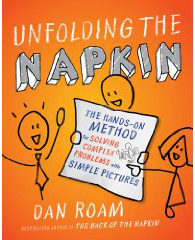 Dan Roam, author of the popular visual thinking book, The Back of the Napkin, has just published a workbook called Unfolding the Napkin: The Hands-On Method for Solving Complex Problems with Simple Pictures. I just picked it up last night at Barnes & Noble, and had a chance to page through it. It looks like a terrific complement to its predecessor.
Dan Roam, author of the popular visual thinking book, The Back of the Napkin, has just published a workbook called Unfolding the Napkin: The Hands-On Method for Solving Complex Problems with Simple Pictures. I just picked it up last night at Barnes & Noble, and had a chance to page through it. It looks like a terrific complement to its predecessor.
Where The Back of the Napkin was an introduction to visual problem solving, Unfolding the Napkin is a hands-on guidebook that shows the reader how to apply these methods and gives you opportunities to try them out on your own business challenges. Think of it as a cookbook for the mind!
Unfolding the Napkin is filled with detailed case studies, guided do-it-yourself exercises, and plenty of blank space for drawing. Roam encourages the reader to view this practical workbook as a four-day visual thinking workshop, with one day devoted to each of the steps of his visual thinking framework: look, see, imagine and show. The book contains only four chapters, one devoted to each of these steps.
Unfolding the Napkin is eminently practical: At one point, in the chapter called “imagination,” Roam walks the reader through a business scenario, in which he asks you to imagine that you’re a project manager. The CEO has just asked you to implement a new idea. But first, you need to convince a number of key stakeholders – managers in finance, manufacturing and the board of directors – to back this new project. Roam shows how his flexible and powerful SQVID framework (simple/elaborate, quantitative/qualitative, vision/execution, individual/comparison and change/status quo) can be used to visually and persuasively communicate the importance of this project to each of these key people.
Why should you be concerned about being a better visual thinker? Roam explains:
“Our world is becoming more information saturated and globalized, and communication is becoming more channelized, every day. Words simply are not enough any more. To discover truly breakthrough ideas, intuitively develop those ideas, and share those ideas effectively with others, we need pictures.”
What does all this have to do with mind mapping? Simply this: You need to be aware of the larger context within which it fits – namely, it’s a method of thinking visually. Roam gives you a flexible set of tools for thinking about problems and challenges that I believe will indirectly help you to grow your skills as a mind mapper. I believe it will help you to think visually in your mind, and then do a better job of transferring your ideas and their relationships from the screen of your mind to paper (or your computer screen).
So if you haven’t picked up The Back of the Napkin or Unfolding the Napkin yet, I strongly encourage you to do so. You’ll be a better thinker and problem solver for it!

Leave a Reply